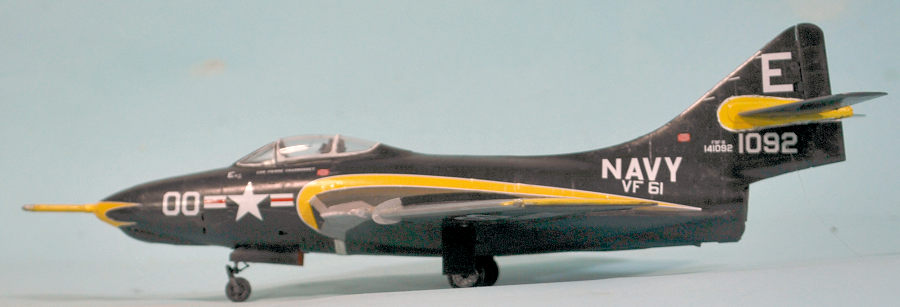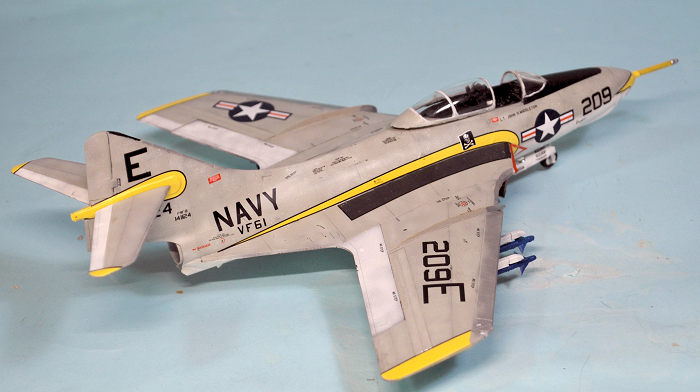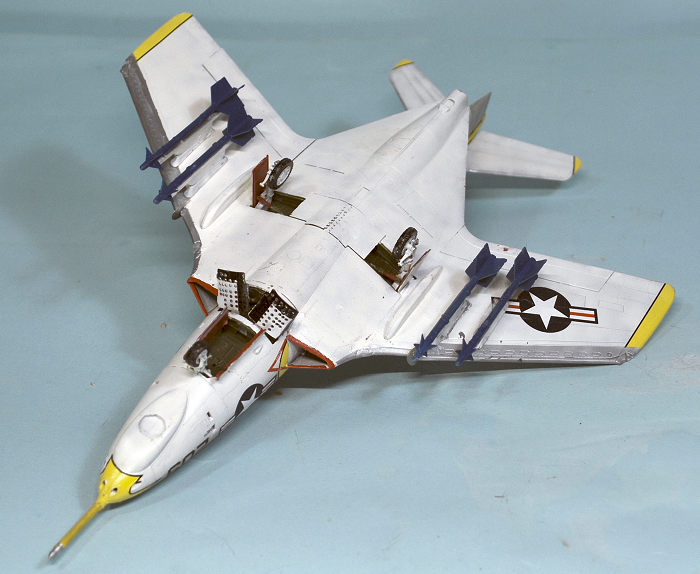
| KIT #: | KH 80127 |
| PRICE: | $71.00 |
| DECALS: | Five options |
| REVIEWER: | Tom Cleaver |
| NOTES: | Furball “Sea Blue F9F-8 Cougars” (F/D&S-4803) |

| HISTORY |
By the time
Grumman’s F9F-2 Panther was entering fleet service in 1949, the advantages of
swept wings had already been proven by the North American F-86 Sabre which had
flown in prototype form within months of the XF9F-2. The big question posed by
this development for naval aviation was, could a swept-wing jet - with all its
low-speed control difficulties and need for a higher landing speed - be tamed to
the point  it
could be brought aboard an aircraft carrier? There were those naysayers -as
there have been at every technological advance related to naval aviation - who
thought otherwise and predicted that the new developments in jets would make the
aircraft carrier obsolete. Most of these people wore black shoes with their
uniforms.
it
could be brought aboard an aircraft carrier? There were those naysayers -as
there have been at every technological advance related to naval aviation - who
thought otherwise and predicted that the new developments in jets would make the
aircraft carrier obsolete. Most of these people wore black shoes with their
uniforms.
Grumman believed that if a swept-wing Panther was to use the same low-speed control devices as the Panther used - leading edge slats and large flaps - that the problem could be overcome. In anticipation of the Navy agreeing with them, the company initiated initial design studies.
It didn’t take the Navy long to discover that their new Panther could only stay in the same sky with the MiG-15 by dint of superior pilot ability, when Panthers tangled with MiGs in the fall of 1950. The Navy suddenly wanted swept wings, and they wanted them fast. The Grumman proposal for a swept-wing Panther looked like a way to do that with minimum difficulty and maximum quick time frame.
By the time the Navy decided to proceed, the higher-powered F9F-5 Panther was in production. The XF9F-6 swept-wing prototype was an F9F-5 with minimal changes to put wings and horizontal stabilizers swept back 35 degrees on the Panther’s fuselage.
The prototype flew on September 20, 1951, and flew well. With the added kick of wartime, testing went forward and it was carrier-qualified in the early spring of 1952. By that time the Navy had ordered it into production and Grumman had given it the name “Cougar.” VF-32 became the first squadron declared operational with the Cougar in December 1952. Maximum speed at sea level was 650 m.p.h. - a very useful increase over the Panther - with 590 m.p.h. possible at 35,000 feet. Not only that, the Cougar could pierce the still-dangerous “sound barrier” in a dive - not by much, but still it did it; this is surprising, since the horizontal stabilizers were in exactly the wrong place for supersonic flight, which may have limited performance beyond Mach 1. The most notable event in the history of the F9F-6 came on April 1, 1954, when VF-21 flew three Cougars from NAS North Island to Floyd Bennet Field, New York, with LCDR F.X. Brady setting a transcontinental speed record of 3 hours, 45 minutes and 30 seconds.
 The
definitive Cougar was the F9F-8, known to Grumman as the G-99. There were many
changes over the earlier airplane, the most noticeable of which was the wing.
Wing chord outboard of the fences was increased, giving the leading edge a
sawtooth that made the Cougar definitely supersonic in a dive with better
control. The leading edge slats were deleted while the new leading edge had
increased camber which improved stability and handling at low speeds and high
angles of attack - important for “coming aboard.” The large trailing edge fillet
extended the length of the fuselage. The large wing increased internal fuel
capacity to 1,063 gallons, while new 150-gallon tanks could be carried. The
F9F-8 was also capable of in-flight refueling with a nose probe installed at the
factory. With similar gun armament tp the F9F-6, the F9F-8 could also carry four
new Sidewinder missiles, as well as a substantial underwing bomb load that
eventually included a nuclear device. The Blue Angels finally turned in their
Panthers for good at the end of the 1955 season (when I saw them) and converted
on to the F9F-8 (which I also saw them fly) that equipped the team until 1958.
The
definitive Cougar was the F9F-8, known to Grumman as the G-99. There were many
changes over the earlier airplane, the most noticeable of which was the wing.
Wing chord outboard of the fences was increased, giving the leading edge a
sawtooth that made the Cougar definitely supersonic in a dive with better
control. The leading edge slats were deleted while the new leading edge had
increased camber which improved stability and handling at low speeds and high
angles of attack - important for “coming aboard.” The large trailing edge fillet
extended the length of the fuselage. The large wing increased internal fuel
capacity to 1,063 gallons, while new 150-gallon tanks could be carried. The
F9F-8 was also capable of in-flight refueling with a nose probe installed at the
factory. With similar gun armament tp the F9F-6, the F9F-8 could also carry four
new Sidewinder missiles, as well as a substantial underwing bomb load that
eventually included a nuclear device. The Blue Angels finally turned in their
Panthers for good at the end of the 1955 season (when I saw them) and converted
on to the F9F-8 (which I also saw them fly) that equipped the team until 1958.
The prototype F9F-8 - an F9F-6 with the new wing - flew on December 18, 1953, and the first production airplane flew a month later, on January 18, 1954. Squadron service was initiated rapidly and more Cougars were on carrier decks in the late 1950s than any other type. After leaving first-line fleet service at the end of the 1950s, the F9F-8 flew on with the Reserves and as a single-seat fighter trainer in Naval Air Training Command until 1971, long after all its contemporaries - as well as its replacements, the F-11F-1 and F3H-2 - had been sent to the boneyard. Along with the F-14, the F9F Panther/Cougar series were Grumman’s most successful jet fighters.
| THE KIT |
When this
kit was originally released by Kitty Hawk in 2014, I and several other reviewers
noted that it was molded in some strange plastic that was resistant to modern
“hot” glues like Tamiya Extra Thing, both regular and fast-drying. The parts fit
was also criticized. A few models were successfully created by some determined
modelers, but in my case both the F9F-8 and the trainer ended up in the round
file and confirmed my belief that Kitty Hawk was the worst kit maker in the
business. It didn’t help that the kit designer was actually crazy (He once
posted at FleeceBlock that he hoped to die in a shootout with the FBI - yes! No
kidding!) T he
dreadful Banshee confirmed nothing good was coming from this company, with the
nail in the coffin being their F-101A/B and RF-101C Voodoo kits. A turnaround
with the release of the well-designed FJ-2 and FJ-4 Fury fighters came just as
the company announced it was going out of business in 2021.
he
dreadful Banshee confirmed nothing good was coming from this company, with the
nail in the coffin being their F-101A/B and RF-101C Voodoo kits. A turnaround
with the release of the well-designed FJ-2 and FJ-4 Fury fighters came just as
the company announced it was going out of business in 2021.
The rumors that Kitty Hawk had been bought by Trumpeter started in 2022, but as it turned out, the real purchaser was Zimi Models, which has re-released the kits as Kitty Hawk starting in late 2023. The F9F-8 Cougar was in the third group of re-releases, appearing in late May 2024.
The kit is exactly what was released back in 2014, with the option of doing the model as an F9F-8 fighter or F9F-8P photo recon bird, with decal options of a Sea Blue F9F-8 from VF-121, a gull grey/white F9F-8 from VF-61, the Blue Amgels Lead plane, and a gull grey/white F9F-8P from VFP-63 and an orange-and-white 8P.
The excellent Furbasll Aero Design decal sheets for Sea Blue and Grey-White Cougars are still available from the company to those modelers whose Paypal account is not convinced they are in Canada as mine is). I was able to find a Sea Blue Cougar sheet from an eBay dealer, for which I ”paid through the nose.”
| CONSTRUCTION |
Since the Kitty Hawk Cougar was the only kit of this plane released in anything approaching “mainstream injection molding,” and having had a good experience with the FJ-2 and FJ-3 kits, I decided to pick one up when Squadron put them on pre-order. When it arrived in early June, the first thing I did was cut to piece of sprue and glue them together with Tamiya Extra Thin quick-drying cement. Voila! It worked.
This kit may look exactly like a mainstream injection molded kit, but the inaccuracies in design and poor fit of parts means that you should consider it a “high end limited run” kit if you want to achieve success.
Halfway through the battle to build the kit, I decided to consider it my “learning kit” and purchased a second one that would be the “done right” kit. The tips on how to get from here to finished are from mistakes made on the first one and corrected on the second one.
 For starters,
ignore most of the instructions on how to assemble this kit. To assemble the
fuselage, assemble the three-piece fuselage halves into one complete fuselage
half before proceeding further, and also attach the upper inner wing part at
this point. You need to open the slots wider and make certain ther slots
correlate with the relevant tab. Test fit four times before committing to glue
once. Assembling each fuselage half this way allows you to work the various
joints from inside and outside to get solid fit that won’t need puttying.
For starters,
ignore most of the instructions on how to assemble this kit. To assemble the
fuselage, assemble the three-piece fuselage halves into one complete fuselage
half before proceeding further, and also attach the upper inner wing part at
this point. You need to open the slots wider and make certain ther slots
correlate with the relevant tab. Test fit four times before committing to glue
once. Assembling each fuselage half this way allows you to work the various
joints from inside and outside to get solid fit that won’t need puttying.
Be careful when attaching the cockpit tub and nose gear tubs to the fuselage half, to be sure that they are perfectly horizontal before gluing the fuselage halves together. One the halves are glued together, attach a tab to the lower fuselage right behind the nosewheel/dive brake tub, so the forward end of the lower fuselage center section will have something to attach to and insure a solid joint.
The kit design makes extending the wings difficult. Do not use the inner plates on the wing and the fuselage. Instead, glue tabs into the opening on the assembled fuselage, then fit the wing onto those and then glue the wing to the fuselage. I used Tamiya Ultra Thin regular glue, to give time to squeeze the wing to the fuselage and get a nice smooth joint.
Do not glue the nose cap on until you have most of the rest of the airframe assembled, then fill the nose with weights sufficient to insure nose-sitting, and then attach the nose cap and close things up.
| COLORS & MARKINGS |
For both kits, I first painted the wing and tail leading edges with Tamiya LP 11 “Silver” lacquer metallic. I let it dry overnight, then masked those areas with Tamiya tape. I masked off the canopies and windshields and shot them with Mr Color C316 “White FS17676.” I masked off those areas for later painting with the airframe color.
I painted the yellow wing tips for the Sea Blue Cougar and masked them off. The airframe was then painted with Mr Color C71 “Midnight Blue.”
 The grey/white
Cougar was shot with Mr Color C316 “White FS17676" on the lower surfaces and Mr
Color C11 “Light Gull Grey” on the upper surfaces.
The grey/white
Cougar was shot with Mr Color C316 “White FS17676" on the lower surfaces and Mr
Color C11 “Light Gull Grey” on the upper surfaces.
The Sea Blue Cougar was marked as the CAG bird from VF-61, using the Furball Aewro Design/Detail & Scale “Colorful Sea Blue F9F-8 Cougars, F/D&S-4803. The decals went down easily and only needed a single application of Micro-Sol to set up.
The grey/white Cougar used the Kitt Hawk decal sheet supplied with the kit. These decals also went down easily with Micro-Sol. The Sea Blue model was given a coat of Micro Clear Satin to seal everything. IO used the Clear Satin on the lower surfaces of the grey-white model, and Micro Clesar Flat on the upper surfaces.
I attached the landing gear for both kits, and the open dive brakes and Sidewinder launch rails on the grey-white model. I modified the kit-provided Sidewinders (which are AIM-9L) to look more like AIM-9B missiles and painted them blue to simulate inert training rounds.
| CONCLUSIONS |
This is still a kiot from the Kittuy Hawk Difficult Kits Division. Treat it like a high-end limited-run kit and take care to assemble as suggested and all will be well. It’s still the only close-to-good 1/48 F9FG-8 Cougar out there.
Recommended for modelers with experience building high-end limited-run kits.
Review kits courtesy of all you book buyers.
Tom Cleaver
4 July 2024
Copyright ModelingMadness.com. All rights reserved. No reproduction in part or in whole without express permission from the editor.
If you would like your product reviewed fairly and fairly quickly, please contact the editor or see other details in the Note to Contributors.